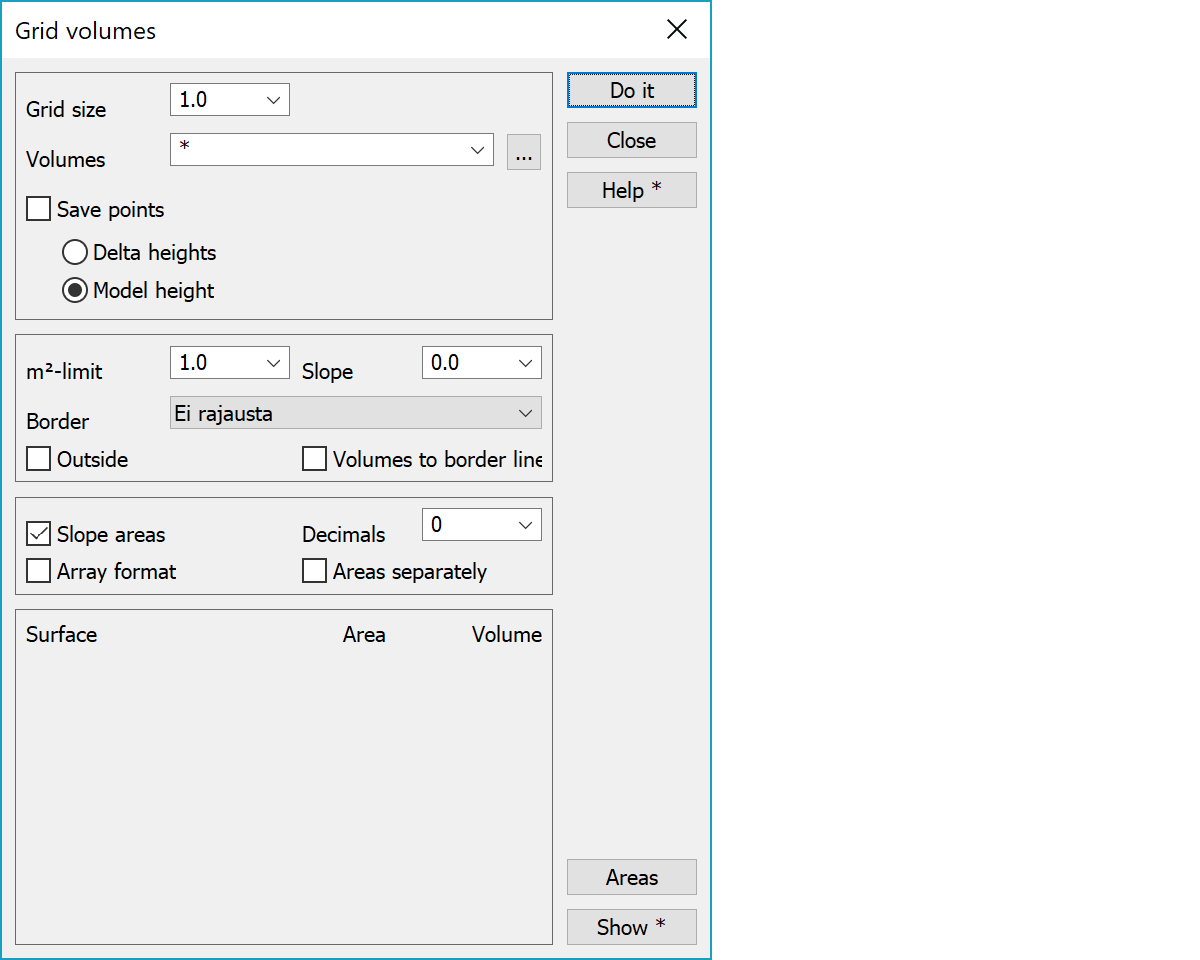 Grid volumes
Grid volumes Grid volumes
Grid volumesVolume calculation method based on square grid. Area covered by all available models is calculated using given grid size. Volumes are calculated using model height of every model in each grid point.
Volume calculation is based on surface codes. Be sure to have the correct codes, and if need be, change the codes in edit model.
The dialog shows the area and volume of the some surfaces. Rest of the volumes and surfaces will be shown in the result file. Volume calculation results are stored also to file as attributes. Volume attributes are named VOL_x, where the x is surface id. For example, rock volumes are stored to attribute VOL_2. These attributes can be used to show volumes on screen using title files.

Grid size for calculation.
Define a list of volumes to be saved in result file and painted in screen. Volumes are always calculated using all available surfaces. Select * (asterisk) to include all volumes. Volume colors are defined in code file. Feature code is generated by joining 9800 and surface code. Surface 1 will get feature code 9801. This settings is restored back to the default value * at program startup.
Browse button opens the surface selection list. Volume subtypes like 2.1 are not selected separately. Calculation handles either all surface 2 related volums or none of them. Browse button with the Shift-key opens list editing.
The volume list can contain label prefix separated by equal sign (e.g. Name=1,2). Namespaces can be handled with colon character. For example, KA:* or just KA: selects all volumes from the namespace KA. Likewise, *:11 or just :11 selects construct volumes from all namespaces.
By default only topmost volume areas are stored. Save points setting stores also single points to grid centers for all used surfaces. Point heights are either differences to lower surface or original model heights.
Value m²-limit is thickness limit for rock volumes (2). If the thickness of rock is lower than this value, it is listed separately as area. Slope is minimum slope for bottom of the rock volume. If the construct surface slope is steeper than given value, rock is handled as volume regardless its thickness.
The border file name. The border file is normal vector file in the element list. The lines in the file will be inserted to the result file and only triangles within the border will be calculated. If there are several border lines, volumes are calculated separately for each area. Border lines must be closed and thay must have line number, which is used as a area id in the result file. If the border lines overlap, volumes are added only to the first area.
Calculates volumes outside of given border file lines.
Stores calculated volumes to border line attributes.
Includes slope areas of all surfaces into result file. Areas are calculated only from upper surface of the surface volume areas.
Determines the format of the result file. If the checkbox is selected, array format is used. Otherwise, list format is used. Array format is more suitable for transferring results to spreadsheet program. See examples at the bottom of page.
Number fo decimals in volume calculation results. Negative values round to nearest power of ten: -1 to nearest 10 and -2 to nearest 100.
Every area separately, if border file has multiple lines. Only closed lines can be used as border lines.
Saves volume areas to a new vector element.
The results of the volume calculation are displayed in the result file [user]/volume_grid.txt. You can view the results in text editor after the calculation. Settings affecting format of the result can be changed and the result file displayed again without recalculation of volumes.
With the Shift-key the result file is written using tabulators as column separators. This makes it easy to copy result value columns to Excel. Decimal separator is comma by default, but it can be changed with special setting ResultDecimal. With the Alt-key the result file is written with template file.
The surface names are set in the code file. Notice that you can specify two names separated by semicolon where the latter one is used in result file for volume calculation.
There are also two other methods for volume calculation: combine models and cross sections.
Example of list type output:
Volume Calculation : Square grid
Z-limit: 1.00 (Slope 7.00)
Border file: C:\Users\Mikko\Data\Model\Volume\Kasa\raja.xyz
Files:
C:\Users\Mikko\Data\Model\Volume\Kasa\kasa.ne0
Grid size: 1.0
Total
Surface Area Volume Code
Täyttö 9725.00 74040.70 11
Area: Area1
Surface Area Volume Code
Täyttö 5707.00 26637.90 11
Area: Area2
Surface Area Volume Code
Täyttö 4018.00 47402.80 11
Example of array type output:
Volume Calculation : Square grid
Z-limit: 1.00 (Slope 7.00)
Border file: C:\Users\Mikko\Data\Model\Volume\Kasa\raja.xyz
Files:
C:\Users\Mikko\Data\Model\Volume\Kasa\kasa.ne0
Grid size: 1.0
Surface Täyttö (11)
Area Volume
Area: Area1 5707.00 26637.90
Area: Area2 4018.00 47402.80
Total 9725.00 74040.70
There are some special settings related to this function.
If not zero, calculates rock drill areas for locations where construction steepness is greater than the given limit.
Decimal separator used with tabulated result file. Either comma (0) or point (1).
See also: Using special settings